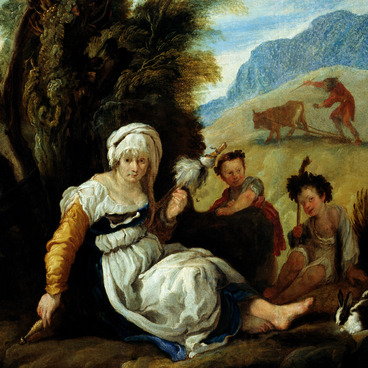This hunting closet belongs to a rare type of open storefronts for storing and displaying hunting weapons. It entered the museum from the Olsufiev estate in the village of Krasnye Buytsy, Tula Governorate. The last owner of the estate Yuri Olsufiev was an art critic, restorer, museum figure, one of the founders and organizers of the Commission for the Protection of Art Monuments and antiquities of the Trinity Lavra of St Sergius and The Sergiev Posad State History and Art Museum-Reserve.
At the invitation of the artist Igor Grabar, Olsufiev joined the position of research associate at the Central State Restoration Workshops in Moscow in 1928. From 1934, he directed the restoration section of Old Russian painting of the Tretyakov Gallery.
The luxurious multi-tiered oak cabinet is made in Baroque style, abundantly decorated with carved and sculptural details. The topper of the closet is decorated with figures of Putti babies, who hold the head of a deer among the garlands of oak branches and trumpet into hunting horns. Putti is a characteristic Baroque element of decor. On the central cabinet door, carvings depict hunting trophies — a bird and a hare. Skillfully carved hunting dogs guard the foot of the closet. Custom made, the unique hunting closet bears the imprint of not only the individuality of the master but also the customer.
The item underwent a large-scale restoration in the All-Russian Art Scientific and Restoration Center named after, I.E. Grabar in 2017. The old varnish was removed with scalpels, without chemical reagents. Carvings and stone inserts were restored — now it is green Italian marble; the structure was reinforced, lost locks were made and installed. The restorer manually performed the restoration of oak branches on top of the cabinet and other small carved parts. In particular, one of the dogs’ paws were recreated, focusing on similar figures that embellish the fireplace ensemble at the San Francisco Museum. They did not restore fasteners for the guns on the closet’s sides because no analogs could be found. During the restoration, it was defined that the bottom notches for the butts of the guns were cut exactly under the old model gun.
At the invitation of the artist Igor Grabar, Olsufiev joined the position of research associate at the Central State Restoration Workshops in Moscow in 1928. From 1934, he directed the restoration section of Old Russian painting of the Tretyakov Gallery.
The luxurious multi-tiered oak cabinet is made in Baroque style, abundantly decorated with carved and sculptural details. The topper of the closet is decorated with figures of Putti babies, who hold the head of a deer among the garlands of oak branches and trumpet into hunting horns. Putti is a characteristic Baroque element of decor. On the central cabinet door, carvings depict hunting trophies — a bird and a hare. Skillfully carved hunting dogs guard the foot of the closet. Custom made, the unique hunting closet bears the imprint of not only the individuality of the master but also the customer.
The item underwent a large-scale restoration in the All-Russian Art Scientific and Restoration Center named after, I.E. Grabar in 2017. The old varnish was removed with scalpels, without chemical reagents. Carvings and stone inserts were restored — now it is green Italian marble; the structure was reinforced, lost locks were made and installed. The restorer manually performed the restoration of oak branches on top of the cabinet and other small carved parts. In particular, one of the dogs’ paws were recreated, focusing on similar figures that embellish the fireplace ensemble at the San Francisco Museum. They did not restore fasteners for the guns on the closet’s sides because no analogs could be found. During the restoration, it was defined that the bottom notches for the butts of the guns were cut exactly under the old model gun.



